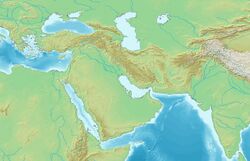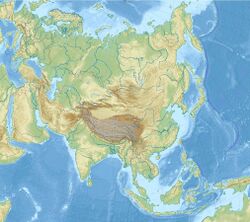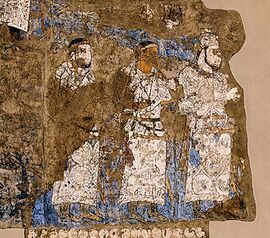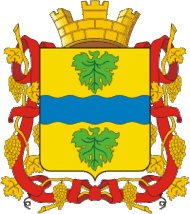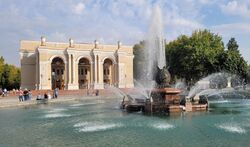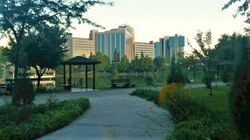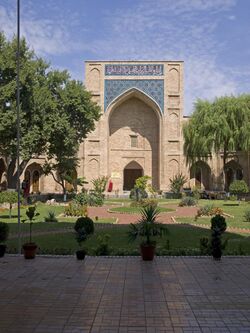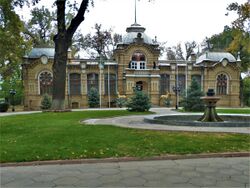Tashkent
Topic: Place
 From HandWiki - Reading time: 25 min
From HandWiki - Reading time: 25 min
Tashkent Тошкент Toshkent | |
|---|---|
Capital city | |
Clockwise from top: Skyline of Tashkent, Kukeldash Madrasa, Cathedral of the Dormition of the Mother of God, Supreme Assembly building, Amir Timur Museum, Humo Ice Dome, Hilton Tashkent City, Tashkent at night. | |
| Nickname(s): Tash (A rock) | |
| Motto(s): Kuch Adolatdadir! ("Strength is in Justice!") | |
| <mapframe zoom="8" frameless="1" height="200" latitude="41.31" longitude="69.28" width="300">{"properties":{"stroke-width":2,"stroke":"#000000","title":"Tashkent"},"type":"ExternalData","service":"geoshape"}</mapframe> Location of Tashkent in Uzbekistan | |
| Coordinates: [ ⚑ ] : 41°18′40″N 69°16′47″E / 41.31111°N 69.27972°E | |
| Country | |
| Settled | 3rd century BCE |
| Divisions | 12 districts |
| Government | |
| • Type | City Administration |
| • Hakim (Mayor) | Shavkat Umrzakov |
| Area | |
| • Capital city | 449 km2 (173 sq mi) |
| Elevation | 455 m (1,493 ft) |
| Population (1 July 2023)[2] | |
| • Capital city | 3,000,000 [1] |
| • Rank | 1st in Uzbekistan |
| • Metro | 6,986,602 |
| Time zone | UTC+5 ( ) |
| Area code(s) | 71 |
| Vehicle registration | 01 |
| HDI (2019) | 0.809[3] very high |
| International Airports | Islam Karimov Tashkent International Airport |
| Rapid transit system | Tashkent Metro |
| Website | tashkent |
Tashkent (/tæʃˈkɛnt/, US also /tɑːʃ-/; Russian: Ташкент) or Toshkent (/tɒʃˈkɛnt/; Uzbek: Тошкент / تاشکند, Template:IPA-uz); historically known as Chach, Shash, Binkat) is the capital and largest city of Uzbekistan. It is the most populous city in Central Asia, with a population of 3 million.[4] It is located in northeastern Uzbekistan, near the border with Kazakhstan.
Before Islamic influence started in the mid-8th century AD, Tashkent was influenced by the Sogdian and Turkic cultures. After Genghis Khan destroyed it in 1219, it was rebuilt and profited from the Silk Road. From the 18th to the 19th centuries, the city became an independent city-state, before being re-conquered by the Khanate of Kokand. In 1865, Tashkent fell to the Russian Empire; it became the capital of Russian Turkestan. In Soviet times, it witnessed major growth and demographic changes due to forced deportations from throughout the Soviet Union. Much of Tashkent was destroyed in the 1966 Tashkent earthquake, but it was rebuilt as a model Soviet city. It was the fourth-largest city in the Soviet Union at the time, after Moscow, Leningrad and Kyiv.[5]
Today, as the capital of an independent Uzbekistan, Tashkent retains a multiethnic population, with ethnic Uzbeks as the majority. In 2009, it celebrated its 2,200 years of written history.[6]
History
Etymology
During its long history, Tashkent has undergone various changes in names and political and religious affiliations. Abu Rayhan Biruni wrote that the city's name Tashkent comes from the Turkic tash and kent, literally translated as "Stone City" or "City of Stones".[7]
Ilya Gershevitch (1974:55, 72) (apud Livshits, 2007:179) traces the city's old name Chach back to Old Iranian *čāiča- "area of water, lake" (cf. Čaēčista, the Aral Sea's name in the Avesta) (whence Middle Chinese transcription *źiäk > standard Chinese Shí with Chinese character 石 for "stone"[8][9]), and *Čačkand ~ Čačkanθ was the basis for Turkic adaptation Tashkent, popularly etymologized as "stone city".[10] Livshits proposes that Čač originally designated only the Aral Sea before being used for the Tashkent oasis.[10]
Ünal (2022) critiques Gershevitch's and Livshits's etymology as being "based on too many assumptions". He instead derives the name Čač from Late Proto-Turkic *t1iāt2(ă) "stone", which he proposes to be seemingly another translation, besides the apparent Chinese translation 石 shí "stone", of *kaŋk- (whence Chinese transcription 康居 EHC *kʰɑŋ-kɨɑ > standard Chinese Kāngjū), which possibly meant "stone". Against Harold Walter Bailey's and Edwin G. Pulleyblank's suggested Tocharian origin for *kaŋk-, Ünal proposes that it was instead an Iranian word and compares it to Pashto kā́ṇay "stone".[11]
Early history
Tashkent was first settled some time between the 5th and 3rd centuries BC by ancient people as an oasis on the Chirchik River, near the foothills of the West Tian Shan Mountains. In ancient times, this area contained Beitian, probably the summer "capital" of the Kangju confederacy.[12] Some scholars believe that a "Stone Tower" mentioned by Ptolemy in his famous treatise Geography, and by other early accounts of travel on the old Silk Road, referred to this settlement (due to its etymology). This tower is said to have marked the midway point between Europe and China . Other scholars, however, disagree with this identification, though it remains one of four most probable sites for the Stone Tower.[13][14]
History as Chach
In pre-Islamic and early Islamic times, the town and the province were known as Chach. The Shahnameh of Ferdowsi also refers to the city as Chach.
The principality of Chach had a square citadel built around the 5th to 3rd centuries BC, some 8 km (5.0 mi) south of the Syr Darya River. By the 7th century AD, Chach had more than 30 towns and a network of over 50 canals, forming a trade center between the Sogdians and Turkic nomads. The Buddhist monk Xuanzang (602/603? – 664 AD), who travelled from China to India through Central Asia, mentioned the name of the city as Zhěshí (赭時). The Chinese chronicles History of Northern Dynasties, Book of Sui, and Old Book of Tang mention a possession called Shí 石 ("stone") or Zhěshí 赭時 with a capital of the same name since the fifth century AD.[17]
In 558–603, Chach was part of the Turkic Khaganate. At the beginning of the 7th century, the Turkic Kaganate, as a result of internecine wars and wars with its neighbors, disintegrated into the Western and Eastern Kaganates. The Western Turkic ruler Tong Yabghu Qaghan (618-630) set up his headquarters in the Ming-bulak area to the north of Chach. Here he received embassies from the emperors of the Tang Empire and Byzantium.[18] In 626, the Indian preacher Prabhakaramitra arrived with ten companions to the Khagan. In 628, a Buddhist Chinese monk Xuanzang arrived in Ming Bulak.
The Turkic rulers of Chach minted their coins with the inscription on the obverse side of the "lord of the Khakan money" (mid-8th century); with an inscription in the ruler Turk (7th century), in Nudjket in the middle of the 8th century, coins were issued with the obverse inscription “Nanchu (Banchu) Ertegin sovereign".[19]
Islamic Caliphate
Tashkent was conquered by the Umayyad Caliphate at the beginning of the 8th century.[20]
According to the descriptions of the authors of the 10th century, Shash was structurally divided into a citadel, an inner city (madina) and two suburbs - an inner (rabad-dahil) and an outer (rabad-harij). The citadel, surrounded by a special wall with two gates, contained the ruler's palace and the prison.[21]
Post Caliphate rule
Under the Samanid Empire, whose founder Ismail Samani was a descendant of Persian Zoroastrian convert to Islam, the city came to be known as Binkath. However, the Arabs retained the old name of Chach for the surrounding region, pronouncing it ash-Shāsh (الشاش) instead. Abu Bakr Muhammad ibn Ali ash-Shashi, known as al-Kaffal ash-Shashi (904-975), was born in Tashkent. He was an Islamic theologian, scholar, jurist of the Shafi'i madhhab, hadith scholar and linguist.[citation needed]
After the 11th century, the name evolved from Chachkand/Chashkand to Tashkand. The modern spelling of "Tashkent" reflects Russian orthography and 20th-century Soviet influence.
At the end of the 10th century, Tashkent became part of the possessions of the Turkic state of the Karakhanids. In 998/99 the Tashkent oasis went to the Karakhanid Ahmad ibn Ali, who ruled the north-eastern regions of Mavarannahr. In 1177/78, a separate khanate was formed in the Tashkent oasis. Its center was Banakat, where dirhams of Mu'izz ad-dunya wa-d-din Qilich-khan were minted, in 1195–1197; and of Jalal ad-dunya wa-d-din Tafgach-khakan, in 1197–1206.[22]
Mongol conquest
The city was destroyed by Genghis Khan in 1219 and lost much of its population as a result of the Mongols' destruction of the Khwarezmid Empire in 1220.
Timurid period
Under the Timurid and subsequent Shaybanid dynasties, the city's population and culture gradually revived as a prominent strategic center of scholarship, commerce and trade along the Silk Road. During the reign of Amir Timur (1336-1405), Tashkent was restored and in the 14th-15th centuries Tashkent was part of Timur's empire. For Timur, Tashkent was considered a strategic city. In 1391 Timur set out in the spring from Tashkent to Desht-i-Kipchak to fight the Khan of the Golden Horde Tokhtamysh Khan. Timur returned from this victorious campaign through Tashkent.[23]
The most famous saint Sufi of Tashkent was Sheikh Khovendi at-Takhur (13th to the first half of the 14th century). According to legend, Amir Timur, who was treating his wounded leg in Tashkent with the healing water of the Zem-Zem spring, ordered to build a mausoleum for the saint. By order of Timur, the Zangiata mausoleum was built.
Uzbek Shaybanid's dynasty period
In the 16th century, Tashkent was ruled by the Shaybanid dynasty.[24][25]
Shaybanid Suyunchkhoja Khan was an enlightened Uzbek ruler; following the traditions of his ancestors Mirzo Ulugbek and Abul Khair Khan, he gathered famous scientists, writers and poets at his court, among them: Vasifi, Abdullah Nasrullahi, Masud bin Osmani Kuhistani. Since 1518 Vasifi was the educator of the son of Suyunchhoja Khan Keldi Muhammad, with whom, after the death of his father in 1525, he moved to Tashkent. After the death of his former pupil, he became the educator of his son, Abu-l-Muzaffar Hasan-Sultan.[26]
Later the city was subordinated to Shaybanid Abdullah Khan II (the ruler actually from 1557, officially in 1583–1598), who issued his coins here[27] From 1598 to 1604 Tashkent was ruled by the Shaybanid Keldi Muhammad, who issued silver and copper coins on his behalf.[28]
Kazakh ruled period
In 1598, Kazakh Taukeel Khan was at war with the Khanate of Bukhara. The Bukhara troops sent against him were defeated by Kazakhs in the battle between Tashkent and Samarkand. During the reign of Yesim-Khan,[29] a peace treaty was concluded between Bukhara and Kazakhs, according to which Kazakhs abandoned Samarkand, but left behind Tashkent, Turkestan and a number of Syr Darya cities.
Yesim-Khan ruled the Kazakh Khanate from 1598 to 1628, his main merit was that he managed to unite the Kazakh khanate.
The city was part of Kazakh Khanate between 1598 and 1723.[30]
Tashkent state
In 1784, Yunus Khoja, the ruler of the dakha (district) Shayhantahur, united the entire city under his rule and created an independent Tashkent state (1784-1807), which by the beginning of the 19th century seized vast lands.[31]
Kokand Khanate
In 1809, Tashkent was annexed to the Khanate of Kokand.[32] At the time, Tashkent had a population of around 100,000 and was considered the richest city in Central Asia.
Under the Kokand domination, Tashkent was surrounded by a moat and an adobe battlement (about 20 kilometers long) with 12 gates.[33]
It prospered greatly through trade with Russia but chafed under Kokand's high taxes. The Tashkent clergy also favored the clergy of Bukhara over that of Kokand. However, before the Emir of Bukhara could capitalize on this discontent, the Russian army arrived.
Colonial period

In May 1865, Mikhail Grigorevich Chernyayev (Cherniaev), acting against the direct orders of the Tsar and outnumbered at least 15–1, staged a daring night attack against a city with a wall 25 km (16 mi) long with 11 gates and 30,000 defenders. While a small contingent staged a diversionary attack, the main force penetrated the walls, led by a Russian Orthodox priest. Although the defense was stiff, the Russians captured the city after two days of heavy fighting and the loss of only 25 dead as opposed to several thousand of the defenders (including Alimqul, the ruler of the Kokand Khanate). Chernyayev, dubbed the "Lion of Tashkent" by city elders, staged a hearts-and-minds campaign to win the population over. He abolished taxes for a year, rode unarmed through the streets and bazaars meeting common people, and appointed himself "Military Governor of Tashkent", recommending to Tsar Alexander II that the city become an independent khanate under Russian protection.
The Tsar liberally rewarded Chernyayev and his men with medals and bonuses, but regarded the impulsive general as a loose cannon, and soon replaced him with General Konstantin Petrovich von Kaufman. Far from being granted independence, Tashkent became the capital of the new territory of Russian Turkistan, with Kaufman as first Governor-General. A cantonment and Russian settlement were built across the Ankhor Canal from the old city, and Russian settlers and merchants poured in. Tashkent was a center of espionage in the Great Game rivalry between Russia and the United Kingdom over Central Asia. The Turkestan Military District was established as part of the military reforms of 1874. The Trans-Caspian Railway arrived in 1889, and the railway workers who built it settled in Tashkent as well, bringing with them the seeds of Bolshevik Revolution.
Effect of the Russian Revolution
With the fall of the Russian Empire, the Russian Provisional Government removed all civil restrictions based on religion and nationality, contributing to local enthusiasm for the February Revolution. The Tashkent Soviet of Soldiers' and Workers' Deputies was soon set up, but primarily represented Russian residents, who made up about a fifth of the Tashkent population. Muslim leaders quickly set up the Tashkent Muslim Council (Tashkand Shura-yi-Islamiya) based in the old city. On 10 March 1917, there was a parade with Russian workers marching with red flags, Russian soldiers singing La Marseillaise and thousands of local Central Asians. Following various speeches, Governor-General Aleksey Kuropatkin closed the events with words "Long Live a great free Russia".[34]
The First Turkestan Muslim Conference was held in Tashkent 16–20 April 1917. Like the Muslim Council, it was dominated by the Jadid, Muslim reformers. A more conservative faction emerged in Tashkent centered around the Ulema. This faction proved more successful during the local elections of July 1917. They formed an alliance with Russian conservatives, while the Soviet became more radical. The Soviet attempt to seize power in September 1917 proved unsuccessful.[35]
In April 1918, Tashkent became the capital of the Turkestan Autonomous Soviet Socialist Republic (Turkestan ASSR). The new regime was threatened by White forces, basmachi; revolts from within, and purges ordered from Moscow.
Soviet period
The city began to industrialize in the 1920s and 1930s.
Violating the Molotov–Ribbentrop Pact, Nazi Germany invaded the Soviet Union in June 1941. The government worked to relocate factories from western Russia and Ukraine to Tashkent to preserve the Soviet industrial capacity. This led to great increase in industry during World War II.
It also evacuated most of the German communist emigres to Tashkent.[36] The Russian population increased dramatically; evacuees from the war zones increased the total population of Tashkent to well over a million. Russians and Ukrainians eventually comprised more than half of the total residents of Tashkent.[37] Many of the former refugees stayed in Tashkent to live after the war, rather than return to former homes.
During the postwar period, the Soviet Union established numerous scientific and engineering facilities in Tashkent.
On 10 January 1966, then Indian Prime Minister Lal Bahadur Shastri and Pakistan President Ayub Khan signed a pact in Tashkent with Soviet Premier Alexei Kosygin as the mediator to resolve the terms of peace after the Indo-Pakistani War of 1965. On the next day, Shastri died suddenly, reportedly due to a heart attack. It is widely speculated that Shastri was killed by poisoning the water he drank.[citation needed]
Much of Tashkent's old city was destroyed by a powerful earthquake on 26 April 1966. More than 300,000 residents were left homeless, and some 78,000 poorly engineered homes were destroyed,[38] mainly in the densely populated areas of the old city where traditional adobe housing predominated.[39] The Soviet republics, and some other countries, such as Finland, sent "battalions of fraternal peoples" and urban planners to help rebuild devastated Tashkent.
Tashkent was rebuilt as a model Soviet city with wide streets planted with shade trees, parks, immense plazas for parades, fountains, monuments, and acres of apartment blocks. The Tashkent Metro was also built during this time. About 100,000 new homes were built by 1970,[38] but the builders occupied many, rather than the homeless residents of Tashkent.[citation needed] Further development in the following years increased the size of the city with major new developments in the Chilonzor area, north-east and south-east of the city.[38]
At the time of the collapse of the Soviet Union in 1991, Tashkent was the fourth-largest city in the USSR and a center of learning in the fields of science and engineering.
Due to the 1966 earthquake and the Soviet redevelopment, little architectural heritage has survived of Tashkent's ancient history. Few structures mark its significance as a trading point on the historic Silk Road.
Capital of Uzbekistan
Tashkent is the capital of and the most cosmopolitan city in Uzbekistan. It was noted for its tree-lined streets, numerous fountains, and pleasant parks, at least until the tree-cutting campaigns initiated in 2009 by the local government.[40]
Since 1991, the city has changed economically, culturally, and architecturally. New development has superseded or replaced icons of the Soviet era. The largest statue ever erected for Lenin was replaced with a globe, featuring a geographic map of Uzbekistan. Buildings from the Soviet era have been replaced with new modern buildings. The "Downtown Tashkent" district includes the 22-story NBU Bank building, international hotels, the International Business Center, and the Plaza Building.
The Tashkent Business district is a special district, established for the development of small, medium and large businesses in Uzbekistan. In 2018, construction began on a new Downtown which would include a business district with skyscrapers of local and foreign companies, world hotels such as Hilton Tashkent Hotel, apartments, malls, shops and other entertainment. The construction of the International Business Center is planned to be completed by the end of 2021.[41] Fitch assigns “BB−” rating to Tashkent city, “Stable” forecast.[42]
In 2007, Tashkent was named a "cultural capital of the Islamic world" by Moscow News, as the city has numerous historic mosques and significant Islamic sites, including the Islamic University.[43] Tashkent holds the Samarkand Kufic Quran, one of the earliest written copies of the Quran, which has been located in the city since 1924.[44]
Tashkent is the most visited city in the country,[45] and has greatly benefited from increasing tourism as a result of reforms under president Shavkat Mirziyoyev and opening up by abolishing visas for visitors from the European Union and other developing countries or making visas easier for foreigners.[46]
Tashkent over the years
- Development of Tashkent
The city and the origin of television
The first demonstration of a fully electronic TV set to the public was made in Tashkent in summer 1928 by Boris Grabovsky and his team. In his method that had been patented in Saratov in 1925, Boris Grabovsky proposed a new principle of TV imaging based on the vertical and horizontal electron beam sweeping under high voltage. Nowadays this principle of the TV imaging is used practically in all modern cathode-ray tubes. Historian and ethnographer Boris Golender (Борис Голендер in Russian), in a video lecture, described this event.[47] This date of demonstration of the fully electronic TV set is the earliest known so far. Despite this fact, most modern historians disputably consider Vladimir Zworykin and Philo Farnsworth[48] as inventors of the first fully electronic TV set. In 1964, the contribution made to the development of early television by Grabovsky was officially acknowledged by the Uzbek government and he was awarded the prestigious degree "Honorable Inventor of the Uzbek Soviet Socialist Republic".
Geography and climate

| Tashkent | ||||||||||||||||||||||||||||||||||||||||||||||||||||||||||||
|---|---|---|---|---|---|---|---|---|---|---|---|---|---|---|---|---|---|---|---|---|---|---|---|---|---|---|---|---|---|---|---|---|---|---|---|---|---|---|---|---|---|---|---|---|---|---|---|---|---|---|---|---|---|---|---|---|---|---|---|---|
| Climate chart (explanation) | ||||||||||||||||||||||||||||||||||||||||||||||||||||||||||||
| ||||||||||||||||||||||||||||||||||||||||||||||||||||||||||||
| ||||||||||||||||||||||||||||||||||||||||||||||||||||||||||||
Geography
Tashkent is situated in a well-watered plain on the road between Samarkand, Uzbekistan's second city, and Shymkent across the border. Tashkent is just 13 km from two border crossings into Kazakhstan.
Closest geographic cities with populations of over 1 million are: Shymkent (Kazakhstan), Dushanbe (Tajikistan), Bishkek (Kyrgyzstan), Kashgar (China), Almaty (Kazakhstan), Kabul (Afghanistan) and Peshawar (Pakistan).
Tashkent sits at the confluence of the Chirchiq River and several of its tributaries and is built on deep alluvial deposits up to 15 m (49 ft). The city is located in an active tectonic area suffering large numbers of tremors and some earthquakes.
The local time in Tashkent is UTC/GMT +5 hours.
Climate
Tashkent features a Mediterranean climate (Köppen: Csa) with some humid continental climate influences (Köppen: Dsa).[50] As a result, Tashkent experiences cold and often snowy winters not typically associated with most Mediterranean climates and long, hot and dry summers. Most precipitation occurs during the winter, which frequently falls as snow. The city experiences two peaks of precipitation in the early winter and spring. The slightly unusual precipitation pattern is partially due to its 500 m (1,600 ft) altitude. Summers are long in Tashkent, usually lasting from May to September. Tashkent can be extremely hot during the months of July and August. The city also sees very little precipitation during the summer, particularly from June through September.[51][52]
Script error: No such module "weather box".
Demographics
In 1983, the population of Tashkent amounted to 1,902,000 people living in a municipal area of 256 km2 (99 sq mi). By 1991, the year the Soviet Union dissolved, the city's population had grown to approximately 2,136,600. Tashkent was the fourth most populated city in the former USSR, after Moscow, Leningrad (St. Petersburg), and Kyiv. Nowadays, Tashkent remains the fourth most populous city in the CIS.
As of 2020, the city's population was 2,716,176.[55]
- 78.0% – Uzbeks
- 5% – Russians
- 4.5% – Tatars
- 2.2% – Koryo-saram (Koreans)
- 2.1% – Tajiks
- 1.2% – Uighurs
- 7.0% – other ethnic backgrounds[citation needed]
| Historical population | |||||||||||||||||||||||||||||||||||||||||||||||||||||||||||||||||||||||||||||||||||||||||||||||||
|---|---|---|---|---|---|---|---|---|---|---|---|---|---|---|---|---|---|---|---|---|---|---|---|---|---|---|---|---|---|---|---|---|---|---|---|---|---|---|---|---|---|---|---|---|---|---|---|---|---|---|---|---|---|---|---|---|---|---|---|---|---|---|---|---|---|---|---|---|---|---|---|---|---|---|---|---|---|---|---|---|---|---|---|---|---|---|---|---|---|---|---|---|---|---|---|---|---|
|
| ||||||||||||||||||||||||||||||||||||||||||||||||||||||||||||||||||||||||||||||||||||||||||||||||
| Source: Uzbekistan State Statistics Committee[56][57] and Demoscope.ru[58][59][60][61][62] | |||||||||||||||||||||||||||||||||||||||||||||||||||||||||||||||||||||||||||||||||||||||||||||||||
Uzbek is the main spoken language in Tashkent, though Russian is also spoken as a lingua franca. As in much of Uzbekistan, signage in Tashkent often contains a mix of Latin and Cyrillic scripts.[63][64]
Culture
Districts

bod
Ulugbek
tohur
saray
R e g i o n
Since 2020, when Yangihayot District was created,[65] Tashkent has been divided into the following 12 districts (Uzbek: tumanlar):
| Nr | District | Population (2021)[4] |
Area (km2)[66][65] |
Density (area/km2) |
Map |
|---|---|---|---|---|---|
| 1 | Bektemir | 31,400 | 17.83 | 1,761 | 
|
| 2 | Chilanzar | 260,700 | 29.94 | 8,707 | 
|
| 3 | Yashnobod | 258,800 | 33.7 | 7,680 | 
|
| 4 | Mirobod | 142,800 | 17.1 | 8,351 | 
|
| 5 | Mirzo Ulugbek | 285,000 | 35.15 | 8,108 | 
|
| 6 | Sergeli | 105,700 | 37.36 | 2,829 | 
|
| 7 | Shayxontoxur | 348,300 | 29.7 | 11,727 | 
|
| 8 | Olmazor | 377,100 | 34.5 | 10,930 | 
|
| 9 | Uchtepa | 278,200 | 24 | 11,592 | 
|
| 10 | Yakkasaray | 121,600 | 14.6 | 8,329 | 
|
| 11 | Yunusabad | 352,000 | 40.6 | 8,670 | 
|
| 12 | Yangihayot | 132,800 | 44.20 | 3,005 |
Before Tashkent was conquered by the Russian Empire, it was divided into four districts, or daha in Uzbek:
- Beshyoghoch
- Kukcha
- Shaykhontokhur
- Sebzor
In 1940 it had the following districts (Russian район):
- Oktyabr
- Kirov
- Joseph Stalin
- Frunze
- Lenin
- Kuybishev
By 1981, these were reorganized into the following:[38]
- Bektemir
- Akmal-Ikramov (Uchtepa)
- Khamza (Yashnobod)
- Lenin (Mirobod)
- Kuybishev (Mirzo Ulugbek)
- Sergeli
- Oktober (Shaykhontokhur)
- Sobir Rakhimov (Olmazar)
- Chilanzar
- Frunze (Yakkasaray)
- Kirov (Yunusabad)
Main sights
Due to the destruction of most of the ancient city during the 1917 revolution and, later, the 1966 earthquake, little remains of Tashkent's traditional architectural heritage. Tashkent is, however, rich in museums and Soviet-era monuments. They include:
- Kukeldash Madrasah. Dating back to the reign of Abdullah Khan II (1557–1598) it is being restored by the provincial Religious Board of Mawarannahr Moslems. There is talk of making it into a museum, but it is currently being used as a madrassah.
- Chorsu Bazaar, located near the Kukeldash Madrassa. This huge open air bazaar is the center of the old town of Tashkent. Everything imaginable is for sale. It is one of the major tourist attractions of the city.
- Hazrati Imam Complex. It includes several mosques, shrine, and a library which contains a manuscript Qur'an in Kufic script, considered to be the oldest extant Qur'an in the world. Dating from 655 and stained with the blood of murdered caliph, Uthman, it was brought by Timur to Samarkand, seized by the Russians as a war trophy, and taken to Saint Petersburg. It was returned to Uzbekistan in 1924.[67]
- Qaffol Shoshi mausoleum built in honor of Imam Abu Bakr Muhammad ibn Ali ibn Ismail al-Kaffal ash-Shashi.[68][69]The original tomb did not survive in its initial form. In its current state, the mausoleum was constructed in 1542 by the royal architect of that time, Gulyam Husayn. It is an asymmetrical domed portal mausoleum, known as a khanqah.[70]
- Yunus Khan Mausoleum. It is a group of three 15th-century mausoleums, restored in the 19th century. The biggest is the grave of Yunus Khan, grandfather of Mughal Empire founder Babur.
- Palace of Prince Romanov. During the 19th century Grand Duke Nikolai Konstantinovich, a first cousin of Alexander III of Russia was banished to Tashkent for some shady deals involving the Russian Crown Jewels. His palace still survives in the center of the city. Once a museum, it has been appropriated by the Ministry of Foreign Affairs.
- Alisher Navoi Opera and Ballet Theatre, built by the same architect who designed Lenin's Tomb in Moscow, Aleksey Shchusev, with Japanese prisoner of war labor in World War II. It hosts Russian ballet and opera.
- Fine Arts Museum of Uzbekistan. It contains a major collection of art from the pre-Russian period, including Sogdian murals, Buddhist statues, and Zoroastrian art, along with a more modern collection of 19th and 20th century applied art, such as suzani embroidered hangings. Of more interest is the large collection of paintings "borrowed" from the Hermitage by Grand Duke Romanov to decorate his palace in exile in Tashkent, and never returned. Behind the museum is a small park, containing the neglected graves of the Bolsheviks who died in the Russian Revolution of 1917 and to Osipov's treachery in 1919,[71] along with first Uzbekistani President Yuldosh Akhunbabayev.
- Museum of Applied Arts. Housed in a traditional house originally commissioned for a wealthy tsarist diplomat, the house itself is the main attraction, rather than its collection of 19th and 20th century applied arts.
- State Museum of History of Uzbekistan the largest museum in the city. It is housed in the ex-Lenin Museum.
- Amir Timur Museum, housed in a building with a brilliant blue dome and ornate interior. It houses exhibits of Timur and of President Islam Karimov. To adjacent south of the museum is Amir Timur Square where there is a statue of Timur on horseback, surrounded by some of the nicest gardens and fountains in the city.
- Navoi Literary Museum, commemorating Uzbekistan's adopted literary hero, Alisher Navoi, with replica manuscripts, Islamic calligraphy and 15th century miniature paintings.
- The Tashkent Metro is known for extravagant design and architecture in the buildings. Taking photos in the system was banned until 2018.[72]
The Russian Orthodox church in Amir Temur Square, built in 1898, was demolished in 2009. The building had not been allowed to be used for religious purposes since the 1920s due to the anti-religious campaign conducted across the former Soviet Union by the Bolshevik (communist) government in Moscow. During the Soviet period, the building was used for different non-religious purposes; after independence, it was a bank.
Tashkent also has a World War II memorial park and a Defender of Motherland monument.[73][74][75]
Education
Most important scientific institutions of Uzbekistan, such as the Academy of Sciences of Uzbekistan, are located in Tashkent. There are several universities and institutions of higher education:
- TEAM University
- The Branch of the Russian State University of Oil and Gas (NRU) named after I.M. Gubkin
- Tashkent Automobile and Road Construction Institute
- Tashkent State Technical University
- Tashkent Institute of Architecture and Construction
- Tashkent Institute of Irrigation and Melioration
- International Business School Kelajak Ilmi
- Tashkent University of Information Technologies
- Westminster International University in Tashkent
- Turin Polytechnic University in Tashkent
- National University of Uzbekistan
- University of World Economy and Diplomacy
- Tashkent State Economic University
- Tashkent State Institute of Law
- Tashkent Financial Institute
- State Conservatory of Uzbekistan
- Tashkent Pediatric Medical Institute
- Tashkent State Medicine Academy
- Tashkent State University of Oriental Studies
- Tashkent Islamic University
- British Management University in Tashkent
- Management Development Institute of Singapore in Tashkent
- Tashkent Institute of Textile and Light Industry
- Tashkent Institute of Railway Transport Engineers
- National Institute of Arts and Design named after Kamaleddin Bekhzod
- Inha University Tashkent
- Uzbekistan State University of World Languages
- AKFA UNIVERSITY
- Webster University in Tashkent
- Tashkent Professional College of Information Technologies
Media
- Nine Uzbek language newspapers, four in English, and nine in Russian.
- Several television and cable television facilities, including Tashkent Tower, the second tallest structure in Central Asia.
- Moreover, there are digital broadcasting systems available in Tashkent which is unique in Central Asia.
Transportation
- Tashkent Metro
- Tashkent International Airport is the largest in the country, connecting the city to Asia, Europe and North America.
- Tashkent–Samarkand high-speed rail line
- Trolleybus system was closed down in 2010.
- Tram transport ended on 1 May 2016.
Entertainment and shopping
There are several shopping malls in Tashkent. These include Next, Samarqand Darvoza and Kontinent shopping malls.[76] Most of the malls, including Riviera and Compass mall, were built and are operated by the Tower Management Group.[77] This is part of the Orient Group of Companies.[78]
The capital's most established theatre is the Alisher Navoi Theater, that has regular ballet and opera performances.[79] Ilkhom Theater, founded by Mark Weil in 1976, was the first independent theater in the Soviet Union. The theater still operates in Tashkent and is known for its historical reputation.[80]
Sport
Football is the most popular sport in Tashkent, with the most prominent football clubs being Pakhtakor Tashkent FK, FC Bunyodkor, and PFC Lokomotiv Tashkent, all three of which compete in the Uzbekistan Super League. Footballers Maksim Shatskikh, Peter Odemwingie and Vasilis Hatzipanagis were born in the city.
Humo Tashkent, a professional ice hockey team was established in 2019 with the aim of joining Kontinental Hockey League (KHL), a top level Eurasian league in future. Humo joined the second-tier Supreme Hockey League (VHL) for the 2019–20 season. Humo play their games at the Humo Ice Dome; both the team and arena derive their name from the mythical Huma bird.[81]
Humo Tashkent was a member of the reformed Uzbekistan Ice Hockey League which began play in February 2019.[82] Humo finished in first place at the end of the regular season.
Cyclist Djamolidine Abdoujaparov was born in the city, while tennis player Denis Istomin was raised there. Akgul Amanmuradova and Iroda Tulyaganova are notable female tennis players from Tashkent.
Gymnasts Alina Kabaeva and Israeli Olympian Alexander Shatilov were also born in the city.
Former world champion and Israeli Olympic bronze medalist sprint canoer in the K-1 500 m event Michael Kolganov was also born in Tashkent.[83]
In Weightlifting, Uzbekistan won the heavyweight class in both the Rio.[84] and Tokyo [85]Olympic Games. Tashkent is hosting the 2021 Weightlifting World Championships.[86]
Notable people
- Behzod Abduraimov, classical pianist
- Nodirbek Abdusattorov, chess grandmaster
- Turgun Alimatov, Uzbek classic music and shashmaqam player and composer
- Natasha Alam, Uzbekistani–American actress and model
- Abdulla Aripov, politician and Prime Minister of Uzbekistan
- Lola Astanova, Russian-American pianist
- Viktor Bryukhanov, director of Chernobyl Nuclear Power Plant
- Sogdiana Fedorinskaya, singer and actress
- Gʻafur Gʻulom, poet
- Ravshan Irmatov, football referee
- Arthur Kaliyev, born in Tashkent raised in Staten Island, New York City , American ice hockey player for the Los Angeles Kings of the NHL
- Rustam Kasimdzhanov, chess player, former FIDE World Champion
- Moshe Kaveh (born 1943), Israeli physicist and former President of Bar-Ilan University
- Vladimir Kozlov, Ukrainian-American professional wrestler
- Varvara Lepchenko, American professional tennis player
- Olena Lytovchenko, writer
- Tohir Malik, novelist
- Boris Mavashev, Israeli seismologist
- Alisher Mirzo, painter
- Eson Kandov, singer and musician
- Abdulla Qodiriy, writer
- Mirjalol Qosimov, former player and head coach of the Uzbekistan national football team
- Igor Povalyayev, former professional footballer
- Svetlana Radzivil, high jumper
- Artur Rozyyev, former Russian professional football player
- Dilorom Saidaminova, composer
- Tursunoy Saidazimova, singer
- Shakhida Shaimardanova, composer
- Iroda Tulyaganova, former tennis player
- Alisher Usmanov, born in Chust, spent his childhood in Tashkent
- Milana Vayntrub, American actress and comedian
- Rita Volk, Uzbekistani–American actress
- Hakim Karimovich Zaripov, circus performer
- Farrukh Zokirov, singer
- Zulfiya, writer and poet
- Sodiq Safoyev, first deputy chairperson of the Senate of Uzbekistan's Parliament
- Ali Hamroyev, actor, film director, screenwriter, and film producer
- Abid Sadykov, organic chemist, academician, and politician
- Umid Iskandarov, Uzbek actor
- Ulugʻbek Qodiriv, actor
- Tohir Sodiroqov, singer
- Alisher Uzoqov, actor
Twin towns – sister cities
Tashkent is twinned with:[87]
 Ankara, Turkey[88]
Ankara, Turkey[88] Ashgabat, Turkmenistan[89]
Ashgabat, Turkmenistan[89] Astana, Kazakhstan[90]
Astana, Kazakhstan[90] Berlin, Germany
Berlin, Germany Bishkek, Kyrgyzstan
Bishkek, Kyrgyzstan Cairo, Egypt[91]
Cairo, Egypt[91] Dnipro, Ukraine
Dnipro, Ukraine Kyiv, Ukraine
Kyiv, Ukraine Moscow, Russia
Moscow, Russia Nagoya, Japan
Nagoya, Japan Riga, Latvia
Riga, Latvia Seattle, United States[92]
Seattle, United States[92] Seoul, South Korea
Seoul, South Korea Shanghai, China
Shanghai, China Sverdlovsk, Ukraine
Sverdlovsk, Ukraine
See also
- Gates of Tashkent
- Tashkent Declaration
References
- ↑ "Toshkent shahri (City, Uzbekistan) - Population Statistics, Charts, Map and Location". https://www.citypopulation.de/en/uzbekistan/admin/UZ26__toshkent_shahri/.
- ↑ "Telegram: Contact @poytaxt_uz". https://t.me/poytaxt_uz/27339/.
- ↑ "Sub-national HDI – Area Database – Global Data Lab" (in en). https://hdi.globaldatalab.org/areadata/shdi/.
- ↑ 4.0 4.1 "Urban and rural population by district" (in uz). Tashkent City department of statistics. https://toshstat.uz/files/308/2021---DEMOGRAFIYA/2130/Hududlar-boyicha-shahar-va-qishloq-aholisi-soni.pdf.
- ↑ Praying Through the 100 Gateway Cities of the 10/40 Window, ISBN:978-0-927-54580-8, p. 89.
- ↑ "Юбилей Ташкента. Такое бывает только раз в 2200 лет". http://www.fergananews.com/articles/6299.
- ↑ Sachau, Edward C. Alberuni's India: an Account of the Religion. Philosophy, Literature, Geography, Chronology, Astronomy, Customs, Laws and Astrology of India about AD 1030, vol. 1 London: KEGAN PAUL, TRENCH, TRtJBNBR & CO. 1910. p.298.
- ↑ Čāč at Encyclopædia Iranica
- ↑ Personal Names, Sogdian i. in Chinese sources at Encyclopædia Iranica
- ↑ 10.0 10.1 Livshits, Vladimir (2007). "The Leader of the People of Chach in Sogdian Inscriptions" in Macuch, Maggi, & Sundermann (eds.) Iranian Languages and Texts from Iran and Turan. Ronald E. Emmerick Memorial Volume. p. 179
- ↑ Ünal, Orçun (2022). "On *p- and Other Proto-Turkic Consonants" Sino-Platonic Papers, 325, pp. 45-46
- ↑ Pulleyblank, Edwin G. "The Consonantal System of Old Chinese," Asia Major 9 (1963), p. 94.
- ↑ Dean, Riaz (2022) (in English). The Stone Tower: Ptolemy, the Silk Road, and a 2,000-Year-Old Riddle. Delhi: Penguin Viking. pp. 134 (Map 4), 170. ISBN 978-0670093625.
- ↑ Dean, Riaz (2015). "The Location of Ptolemy's Stone Tower: the Case for Sulaiman-Too in Osh". The Silk Road 13: 76.
- ↑ Baumer, Christoph (18 April 2018) (in en). History of Central Asia, The: 4-volume set. Bloomsbury Publishing. p. 243. ISBN 978-1-83860-868-2. https://books.google.com/books?id=DhiWDwAAQBAJ&pg=RA1-PA243.
- ↑ Whitfield, Susan (2004) (in en). The Silk Road: Trade, Travel, War and Faith. British Library. Serindia Publications, Inc.. p. 110. ISBN 978-1-932476-13-2. https://books.google.com/books?id=ArWLD4Qop38C&pg=PA110.
- ↑ Bichurin, 1950. v. II
- ↑ Golden, P.B. An Introduction to the History of the Turkic Peoples. Series: Turcologica. Wiesbaden: Otto-Harrassowitz. 1992
- ↑ Baratova L. S. Drevnetyurkskiye monety Sredney Azii VI—IKH vv. (tipologiya, ikonografiya, istoricheskaya interpretatsiya). Avtoreferat diss. kand. ist. nauk. — T., 1995, s.12
- ↑ O. G. Bol'shakov. Istoriya Khalifata, t. 4: apogey i padeniye. — Moskva: «Vostochnaya literatura» RAN, 2010
- ↑ Filanovich, M.I. Tashkent (zarozhdeniye i razvitiye goroda i gorodskoy kul'tury). Tashkent, 1983, p.188
- ↑ Kochnev B. D., Numizmaticheskaya istoriya Karakhanidskogo kaganata (991—1209 gg.). Moskva «Sofiya», 2006, p.157,234
- ↑ Fasikh Akhmad ibn Dzhalal ad-Din Mukhammad al-Khavafi. Fasikhov svod. Tashkent: Fan. 1980, p.114
- ↑ Dobromyslov A. I., Tashkent v proshlom i nastoyashchem. Tashkent, 1912, p.9
- ↑ Istoriya Tashkenta. Tashkent: Fan, 1988, p.70
- ↑ Yudin V. P. Materialy po istorii kazakhskikh khanstv XV-XVIII vekov. (Izvlecheniya iz persidskikh i tyurkskikh sochineniy). — Alma-Ata : Nauka, 1969, p.174.
- ↑ Ye. A. Davidovich, Korpus zolotykh i serebryanykh monet Sheybanidov. XVI vek. M., 1992
- ↑ Burnasheva R. Z., Nekotoryye svedeniya o chekanke mednykh monet v Tashkente v XVI—XIX vv. Izvestiya Natsional'noy akademii nauk Kazakhstana, № 1, 2007, p.153
- ↑ "Yesim-Khan". https://www.researchgate.net/publication/331682741.
- ↑ History of Civilizations of Central Asia,Volume V, UNESCO Publishing, page 97,https://unesdoc.unesco.org/ark:/48223/pf0000130205/PDF/130205eng.pdf.multi
- ↑ Istoriya Tashkenta (s drevneyshikh vremon do pobedy Fevral'skoy burzhuazno-demokraticheskoy revolyutsii) / Ziyayev KH. Z., Buryakov YU. V. Tashkent: «Fan», 1988
- ↑ Planet, Lonely. "History in Tashkent, Uzbekistan". https://www.lonelyplanet.com/uzbekistan/tashkent/background/history/a/nar/83060059-d12c-48ec-8718-1d6c939451a5/357844.
- ↑ Istoriya Tashkenta (s drevneyshikh vremyon do pobedy Fevralskoy burzhuazno-demokraticheskoy revolyutsii) / Ziyayev Kh. Z., Buryakov Y.F. Tashkent: «Fan», 1988
- ↑ Jeff Sahadeo, Russian Colonial Society in Tashkent, Indiana University Press, 2007, p188
- ↑ Rex A. Wade, The Russian Revolution, 1917, Cambridge University Press, 2005
- ↑ Robert K. Shirer, "Johannes R. Becher 1891–1958" , Encyclopedia of German Literature, Chicago and London: Fitzroy Dearborn Publishers, 2000, by permission at Digital Commons, University of Nebraska, accessed 3 February 2013
- ↑ Edward Allworth (1994), Central Asia, 130 Years of Russian Dominance: A Historical Overview , Duke University Press, p. 102. ISBN:0-8223-1521-1
- ↑ 38.0 38.1 38.2 38.3 Sadikov, A C et al. (1984) (in ru). Geographical Atlas of Tashkent (Ташкент Географический Атлас) (2 ed.). Moscow. pp. 60, 64.
- ↑ Nurtaev Bakhtiar (1998). "Damage for buildings of different type". Institute of Geology and Geophysics, Academy of Sciences of Uzbekistan. http://iisee.kenken.go.jp/net/hara/uzbekistan/DamageForBuildings.htm.
- ↑ "Good bye the Tashkent Public Garden!". Ferghana.Ru. 23 November 2009. http://enews.fergananews.com/article.php?id=2590.
- ↑ "Tashkent city". http://www.tcibc.uz/about.html?tab=aim.
- ↑ "Fitch присвоило городу Ташкенту рейтинг "BB-", прогноз "Стабильный"" (in uk). https://www.fitchratings.com/research/ru/international-public-finance/fitch-prisvoilo-gorodu-tashkentu-rejting-bb-prognoz-stabil-nyj-17-06-2019.
- ↑ "Moscow News – World – Tashkent Touts Islamic University". Mnweekly.ru. 21 June 2007. http://mnweekly.ru/world/20070524/55252222.html.
- ↑ "Tashkent's hidden Islamic relic". BBC. 5 January 2006. http://news.bbc.co.uk/2/hi/asia-pacific/4581684.stm.
- ↑ "Uzbekistan doubles the number of tourists in 2018". Brussels Express. 23 November 2018. https://brussels-express.eu/uzbekistan-doubles-the-number-of-tourists-in-2018/.
- ↑ "Uzbekistan announces ambition to become major tourist destination". Euractiv. 19 November 2018. https://www.euractiv.com/section/central-asia/news/uzbekistan-announces-ambition-to-become-a-major-tourist-destination/.
- ↑ "Видеолекторий "Ферганы": Изобретение телевидения и Борис Грабовский". http://www.fergananews.com/articles/8089.
- ↑ K. Krull, The boy who invented TV: The story of Philo Farnsworth, 2014
- ↑ "World Weather Information Service – Tashkent". World Meteorological Organisation. http://worldweather.wmo.int/032/c00115.htm.
- ↑ Updated Asian map of the Köppen climate classification system
- ↑ Tashkent Travel. "Tashkent weather forecast". Tashkent, Uzbekistan. http://www.tashkent-travel.com/weather.
- ↑ Happy-Tellus.com. "Tashkent, Uzbekistan travel information". Helsinki, Finland: Infocenter International Ltd.. http://www.happytellus.com/tashkent/uzbekistan.
- ↑
"Error: no
|title=specified when using {{Cite web}}" (in ru). Pogoda.ru.net. http://www.pogodaiklimat.ru/climate.php?id=38457. - ↑ "Tashkent Climate Normals 1991–2020". National Oceanic and Atmospheric Administration. https://www.nodc.noaa.gov/archive/arc0216/0253808/2.2/data/0-data/Region-2-WMO-Normals-9120/Uzbekistan/CSV/Tashkent_38457.csv.
- ↑ "ТАШКЕНТ (город)". Dic.academic.ru. http://dic.academic.ru/dic.nsf/es/89801/%D0%A2%D0%90%D0%A8%D0%9A%D0%95%D0%9D%D0%A2.
- ↑ "Hududlar boʻyicha shahar va qishloq aholisi soni (2010–2021-yillar)" (in uz). Uzbekistan State Statistics Committee. 2021-07-16. https://api.stat.uz/api/v1.0/data/hududlar-boyicha-shahar-va-qishloq-aholisi-soni?lang=uz&format=pdf.
- ↑ "Постоянное среднее число населения" (in ru). Uzbekistan State Statistics Committee. 2013-09-27. http://stat.uz/upload/iblock/f6f/Doimiy%20aholi%20soni.xls.
- ↑ "Демоскоп Weekly - Приложение. Справочник статистических показателей.". http://www.demoscope.ru/weekly/ssp/rus_gub_97.php?reg=86.
- ↑ "Демоскоп Weekly - Приложение. Справочник статистических показателей.". http://www.demoscope.ru/weekly/ssp/ussr59_reg2.php.
- ↑ "Демоскоп Weekly - Приложение. Справочник статистических показателей.". http://www.demoscope.ru/weekly/ssp/ussr70_reg2.php.
- ↑ "Демоскоп Weekly - Приложение. Справочник статистических показателей.". http://www.demoscope.ru/weekly/ssp/ussr79_reg2.php.
- ↑ "Демоскоп Weekly - Приложение. Справочник статистических показателей.". http://www.demoscope.ru/weekly/ssp/sng89_reg2.php.
- ↑ "Uzbekistan: A second coming for the Russian language?". eurasianet. https://eurasianet.org/uzbekistan-a-second-coming-for-the-russian-language.
- ↑ "Uzbekistan: Dead Letter". Chalkboard. 23 July 2007. http://chalkboard.tol.org/uzbekistan-dead-letter/.
- ↑ 65.0 65.1 "Deputies approved the creation of Yangihayot district of Tashkent" (in ru). Gazeta.uz. 9 September 2020. https://www.gazeta.uz/ru/2020/09/09/yangi-hayot/.
- ↑ "Districts". City of Tashkent. https://www.tashkent.uz/en/menu/rajony-.
- ↑ MacWilliams, Ian (5 January 2006). "Tashkent's hidden Islamic relic". BBC News. http://news.bbc.co.uk/2/hi/asia-pacific/4581684.stm.
- ↑ ""KAFFAL ASH-SHOSHI MAQBARASI"". https://legacy.uz/znakomstvo-s-mavzoleem-al-kaffal-ash-shashi/. Retrieved 2023-12-11.
- ↑ "Toshkentning asosiy ziyorat obyektlari bo‘ylab sayyohlik marshruti". https://uzbekistan.travel/uz/o/toshkentning-asosiy-ziyorat-obyektlari-boylab-sayyohlik-marshruti/. Retrieved 2023-12-11.
- ↑ "МА МАВЗОЛЕЙ АБУБЕКРА КАФФАЛЯ АШ-ШАШИ". https://www.centralasia-travel.com/ru/countries/uzbekistan/places/tashkent/kaffal-shashi. Retrieved 2023-12-11.
- ↑ Smele, Jonathan D. (20 November 2015). Historical Dictionary of the Russian Civil Wars, 1916–1926. Rowman & Littlefield. p. 58. ISBN 978-1442252806. https://books.google.com/books?id=QwquCgAAQBAJ&q=osipov+tashkent&pg=PA58. Retrieved 16 May 2016.
- ↑ Inside Uzbekistan's beautiful, rarely-seen metro. 2 October 2018. https://www.nationalgeographic.com/travel/destinations/asia/uzbekistan/pictures-tashkent-metro-underground/.
- ↑ uznews.net, Tashkent's central park is history , 25 November 2009
- ↑ Army memorial dismantled in Tashkent , 24 November 2009
- ↑ Ferghana.ru, МИД России указал послу Узбекистана на обеспокоенность «Наших» , 16 January 2010 (in Russian)
- ↑ Usbekistan: Entlang der Seidenstraße nach Samarkand, Buchara und Chiwa ISBN:978-3-89794-390-2 p. 111
- ↑ "В Ташкенте открылся новый ТРЦ Compass" (in ru). https://uznews.uz/posts/22949.
- ↑ "Главная/EN". https://orientgroup.uz/en.
- ↑ "State Academic Bolshoi Theatre named after Alisher Navoi". https://gabt.uz/en/.
- ↑ "Сайт театра "Ильхом"". http://ilkhom.com/en/.
- ↑ "Bird of Happiness – a symbol of the HC HUMO" (in ru). 22 July 2019. http://uihf.uz/news#tab115.
- ↑ "Uzbekistan eyes to join International Ice Hockey Federation" (in en). 15 February 2019. https://kun.uz/en/news/2019/02/15/uzbekistan-eyes-to-join-international-ice-hockey-federation.
- ↑ "Sports-reference.com". Sports-reference.com. 24 October 1974. https://www.sports-reference.com/olympics/athletes/ko/michael-kolganov-1.html.
- ↑ "Results by Events Old BW". https://iwf.sport/results/results-by-events/results-by-events-old-bw/?event_id=362.
- ↑ "Results by Events". https://iwf.sport/results/results-by-events/.
- ↑ "IWF World Championships". 21 November 2021. https://iwf.sport/event/iwf-world-championships/.
- ↑ "Ну, здравствуй, брат! Города-побратимы Ташкента" (in ru). The Voice of Tashkent. 2015-11-10. http://vot.uz/article/2015/11/10/neobratimi%D0%B5-pobratimi.
- ↑ "Ankaranın Kardeş Şehirleri" (in tr). Ankara. https://www.ankara.bel.tr/genel-sekreter/genel-sekreter-yardimcisi-faruk-cinki/dis-liskiler-daire-baskanligi/ankaranin-kardes-sehirleri/.
- ↑ "Kostroma is looking for a twin city in Turkmenistan". Orient. 2020-07-15. https://orient.tm/en/kostroma-is-looking-for-a-twin-city-in-turkmenistan/.
- ↑ "Международный авторитет Астаны повышают города-побратимы" (in ru). KazInform. 2016-07-06. https://www.inform.kz/ru/mezhdunarodnyy-avtoritet-astany-povyshayut-goroda-pobratimy_a2927628.
- ↑ "Brotherhood & Friendship Agreements". Cairo. http://www.cairo.gov.eg/en/Pages/agreements.aspx.
- ↑ Long, Priscilla (September 12, 1988). "Seattle-Tashkent Peace Park in Uzbekistan is dedicated in Tashkent and at Seattle Center on September 12, 1988.". https://historylink.org/File/3595.
Further reading
- Stronski, Paul, Tashkent: Forging a Soviet City, 1930–1966 (Pittsburgh, University of Pittsburgh Press, 2010).
- Jeff Sahadeo, Russian Colonial Society in Tashkent, 1865–1923 (Bloomington, IN, Indiana University Press, 2010).
External links
- All about capital of Uzbekistan – Tashkent
- Photos of historical monuments and modern buildings in Tashkent
- Recent photos of Tashkent with comments in English
- Disability Information Resource Centre in Tashkent
 |
 KSF
KSF









